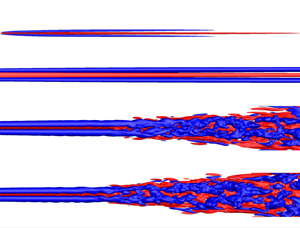Article contents
Bypass transition in a boundary layer flow induced by plasma actuators
Published online by Cambridge University Press: 19 October 2021
Abstract

Bypass transition in flow over a flat plate triggered by a pair of dielectric-barrier-discharge plasma actuators mounted on the plate surface and aligned in the streamwise direction is investigated. A four-species plasma–fluid model is used to model the electrohydrodynamic force generated by the plasma actuation. A pair of counter-rotating streamwise vortices is created downstream of the actuators, leading to the formation of a high-speed streak in the centre and two low-speed streaks on each side. As the length of actuators increases, more momentum is added to the boundary layer and eventually a turbulent wedge is generated at an almost fixed location. With large spanwise distance between the actuators (wide layout), direct numerical simulations indicate that the low-speed streaks on both sides lose secondary stability via an inclined varicose-like mode simultaneously, leaving a symmetric perturbation pattern with respect to the centre of the actuators. Further downstream, the perturbations are tilted by the mean shear of the high- and low-speed streaks and consequently a ‘W’-shaped pattern is observed. When the pair of plasma actuators is placed closer (narrow layout) in the spanwise direction, the mean shear in the centre becomes stronger and secondary instability first occurs on the high-speed streak with an asymmetric pattern. Inclined varicose-like and sinuous-like instabilities coexist in the following breakdown of the negative streaks on the side and the perturbations remain asymmetric with respect to the centre. Here the tilting of disturbances is dominated by the mean shear in the centre and the perturbations display a ‘V’ shape. Linear analysis techniques, including biglobal stability and transient growth, are performed to further examine the fluid physics; the aforementioned phenomena at narrow and wide layouts, such as the secondary instabilities, the ‘V’ and ‘W’ shapes, and the symmetric and asymmetric breakdown, are all observed.
JFM classification
- Type
- JFM Papers
- Information
- Copyright
- © The Author(s), 2021. Published by Cambridge University Press
References
REFERENCES
- 6
- Cited by





